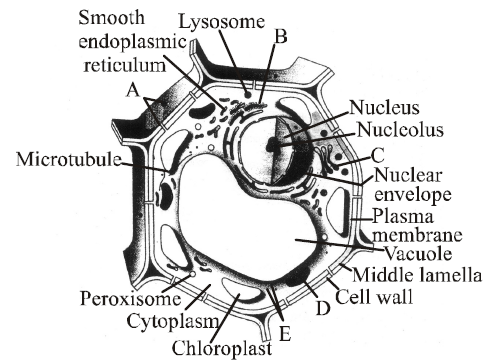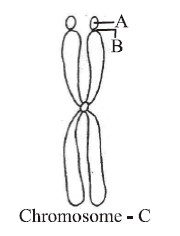The following diagram shows some of the missing structures in a plant cell marked as A, B, C, D E. Choose the option with their correct names.

A - Plasmodesmata, B - Rough endoplasmic reticulum, C - Golgi apparatus, D - Mitochondrion, E - Ribosomes
A - Desmosome, B - Rough endoplasmic reticulum, C - Golgi apparatus, D - Mitochondrion, E - Ribosomes
A - Plasmodesmata, B - Smooth endoplasmic reticulum, C - Golgi apparatus, D - Mitochondrion, E - Ribosomes
A - Tight junction, B - Rough endoplasmic reticulum, C - Golgi apparatus, D - Mitochondrion, E -Ribosomes
Correct Answer :
A. A - Plasmodesmata, B - Rough endoplasmic reticulum, C - Golgi apparatus, D - Mitochondrion, E - Ribosomes
In the given figure of plant cell, the structure marked as A, B, C, D and E are respectively plasmodesmata, rough endoplasmic reticulum, Golgi apparatus, mitochondrion and ribosomes. Plant cells are eukaryotic cell and have certain distinguishing features, including chloroplasts (Photosynthesis takes place) cell walls (allow plants to have strong, upright structures) and intracellular vacuoles (help regulate how cells handle water and storage of other molecules).
Related Questions
Axoneme with 9 + 2 microtubular arrangement occurs in
cilia
flagella
both (a) and (b)
centriole
Choose the wrong statements regarding bacterial cell
- Glycocalyx is the outermost envelope in bacteria.
- The glycocalyx could be a loose sheath called capsule.
- The glycocalyx may be thick and tough called slime layer.
- A special structure formed by the plasma membrane is called mesosome.
- Small bristle like fibres sprouting out of the cell are called fimbriae.
(i) and (iii)
(i) and (ii)
(ii) and (iii)
(i) and (iv)
Match column-I with column-II and choose the correct option.
| Column-I | Column-II |
|---|---|
| A. Tonoplast | I. Contain digestive enzyme |
| B. Contractile vacuole | II. Store metabolic gases |
| C. Food vacuole | III. Excretion |
| D. Air vacuole | IV. Transport of ions in plants |
A IV; B III; C I; D II
A II; B III; C IV; D I
A IV; B II; C III; D I
A I; B III; C II; D IV
Match column-I (scientists) with column-II (discovery) and select the correct option.
| Column-I | Column-II |
|---|---|
| A. Leeuwenhoek | I. First saw and described a living cell |
| B. Robert Brown | II. Presence of cell wall is unique to plant cells |
| C. Schleiden | III. Discovered the nucleus |
| D. Schwann | IV. All plants are composed of different kind of cells |
A I, B III, C IV, D II
A I, B III, C II, D IV
A III, B I, C IV, D II
A I, B IV, C II, D III
Prokaryotic and eukaryotic flagella differ in the
type of movement and placement.
location and mode of functioning.
microtubular structure and function.
microtubular organization and type of movement.
In which method of transport, plasma membrane does not require carrier molecule?
Active transport
Facilitated diffusion
Simple diffusion
Na+ K+ pump
Most of water, in mature plant cells occurs in
nucleus
cell wall
vacuoles
cytoplasm
Which of the following is incorrect ?
Mycoplasma is the smallest cell (0.3 �).
Bacteria are 3 to 5 �m in size.
The largest cell is the egg of an ostrich.
Nerve cells are some of the smallest cells.
A component of cytoskeleton is
microtubule
bone
chitin
cartilage.
Match column-I with column-II and select the correct option.
| Column - I | Column - II |
|---|---|
| A. Golgi apparatus | I. Storage |
| B. Mitochondria | II. Photosynthesis |
| C. Vacuoles | III. Transport |
| D. Grana | IV. Secretion |
| .. | V. Respiration |
A - IV, B - V, C - I, D - II
A - I, B - II, C - IV, D - III
A - IV, B - I, C - II, D - III
A - I, B - II, C - III, D - IV
Cell sap is a
living content of cytoplasm.
nonliving content of cytoplasm.
nonliving content of vacuole.
living content of vacuole.
Match column-I with column-II and select the correct option.
| Column - I | Column - II |
|---|---|
| A. RER | I. Intracellular and extracellular digestion |
| B. Cell wall | II. Provide structural support to the cell |
| C. Flagella | III. Protein synthesis and secretion |
| D. Lysosomes | IV Responsible for cell movement |
A III, B II, C IV, D I
A II, B III, C IV, D I
A I, B III, C II, D IV
A IV, B II, C III, D I
Satellite means
terminal part of the chromosome beyond secondary constriction.
terminal part of the chromosome beyond primary constriction.
terminal part of chromosome beyond tertiary constriction.
none of the above
Match column-I (cell organelle) with column-II membrane and select the correct option from the codes given below.
| Column-I | Column-II |
|---|---|
| A. Mitochondria | I. Without membrane |
| B. Lysosomes | II. Single membrane |
| C. Ribosomes | III. Double membrane |
A - I, B - II, C - III
A - III, B - I, C - II
A - III, B - II, C - I
A - II, B - III, C - I
Polysome is a chain of
oxysomes
sphaerosomes
ribosomes
dictyosomes
Function of RER is
autolysis
protein synthesis
lipid synthesis
carbohydrate synthesis
The following diagram represents a structure chromosome.
Identify the structures marked as A, B and C.

A - Satellite, B - Primary constriction, C - Acrocentric
A - Satellite, B - Secondary constriction, C - Metacentric
A - Satellite, B - Centromere, C - Telocentric
A - Satellite, B - Centromere, C - Submetacentric
Extension of plasma membrane in prokaryotic cell is
mesosome
haploid
ribosome
none of these
The figure below shows the structure of a mitochondrion with its four parts labelled (A), (B), (C) and (D).

Select the part correctly matched with its function.
Part (D): Outer membrane Gives rise to inner membrane by splitting.
Part (B): Inner membrane Forms infoldings called cristae.
Part (C): Cristae Possess single circular DNA molecule and ribosomes.
Part (A): Matrix Major site for respiratory chain enzymes.
Difference between the prokaryotic and eukaryotic cells in having
cell wall
nuclear membrane
ribosome
none of these
Plastids storing fat are called
Elaioplasts
Sphaerosomes
Aleuroplasts
Pyrenoids
Which of the following pair lack the unit membrane?
Nucleus and E.R.
Mitochondria and chloroplast
Ribosome and nucleolus
Golgi body and lysosome
Match column I (cell type) with column II (size) and choose the correct option.
| Column-I | Column-II |
|---|---|
| (Cell type) | (Size) |
| A. Viruses | I. 1-2 ??m |
| B. PPLO | II. 10-20 ??m |
| C. Eukaryotic cell | III. About 0.1 ??m |
| D. Bacterium | IV. 0.02 - 0.2 ??m |
A I, B II, C III, D IV
A IV, B III, C II, D I
A I, B III, C II, D IV
A IV, B II, C III, D I
Which of the following option correctly match A, B, C, and D indicated in the given sectional view of chloroplasts.

A - Thylakoid, B-Stromal lamella, C - Stroma, D - Granum
A - Granum, B - Thylakoid, C - Stromal lamella, D - Stroma
A - Thylakoid, B - Granum, C - Stromal lamella, D - Stroma
A - Granum, B - Thylakoid, C - Stroma, D - Stromal lamella
Which of the following statements is/are correct ?
- The endomembrane system includes plasma membrane, ER, Golgi complex, lysosomes and vacuoles.
- ER helps in the transport of substances, synthesis of proteins, lipoproteins and glycogen.
- Ribosomes are involved in protein synthesis.
- Mitochondria help in oxidative phosphorylation and generation of ATP.
(ii), (iii) & (iv)
(i) only
(ii) only
(iii) only
Which of the following statements are correct ?
- In prokaryotic cells, a special membranous structure formed by the extension of the plasma membrane into the cell is known as polysome.
- The smooth endoplasmic reticulum is the major site for synthesis of glycoproteins.
- RuBisCO is the most abundant protein in the whole biosphere.
- Mitochondria, chloroplasts and peroxisomes are not considered as part of endomembrane system. Of the above statements
(iii) and (iv)
(i) and (ii)
(ii) and (iii)
(i) and (iv)
The cytoskeleton is a proteinaceous network of fibres in the cytoplasm. It is involved in
mechanical support.
motility.
maintenace of cell-shape.
all of the above
Which of the following statement is correct regarding vacuole?
It is membrane-bound and contains storage proteins and lipids.
It is membrane-bound and contains water and excretory substances.
It lacks membrane and contains air.
It lacks membrane and contains water and excretory substances.
Active transport differs from passive transport in that active transport
requires energy.
always requires input of ATP.
moves molecules against a concentration gradient.
both (a) and (c)
Which one of the following structures between two adjacent cells is an effective transport pathway?
Plasmodesmata
Plastoquinones
Endoplasmic reticulum
Plasmalemma
